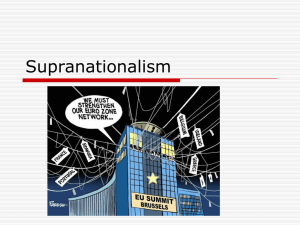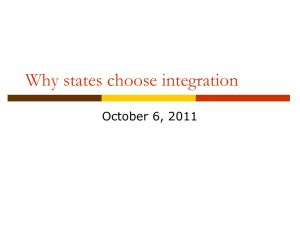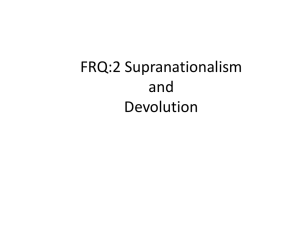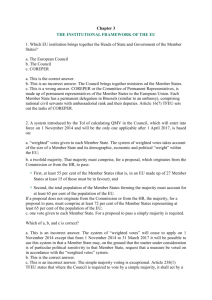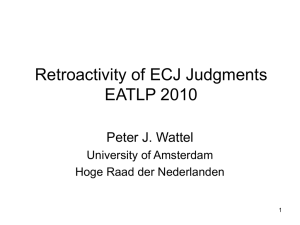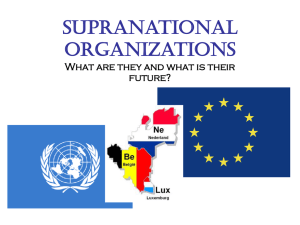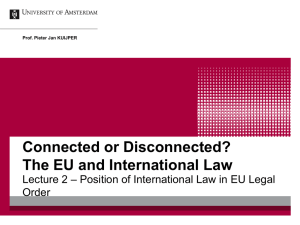Competition in Kirshberg: The European Court of
advertisement
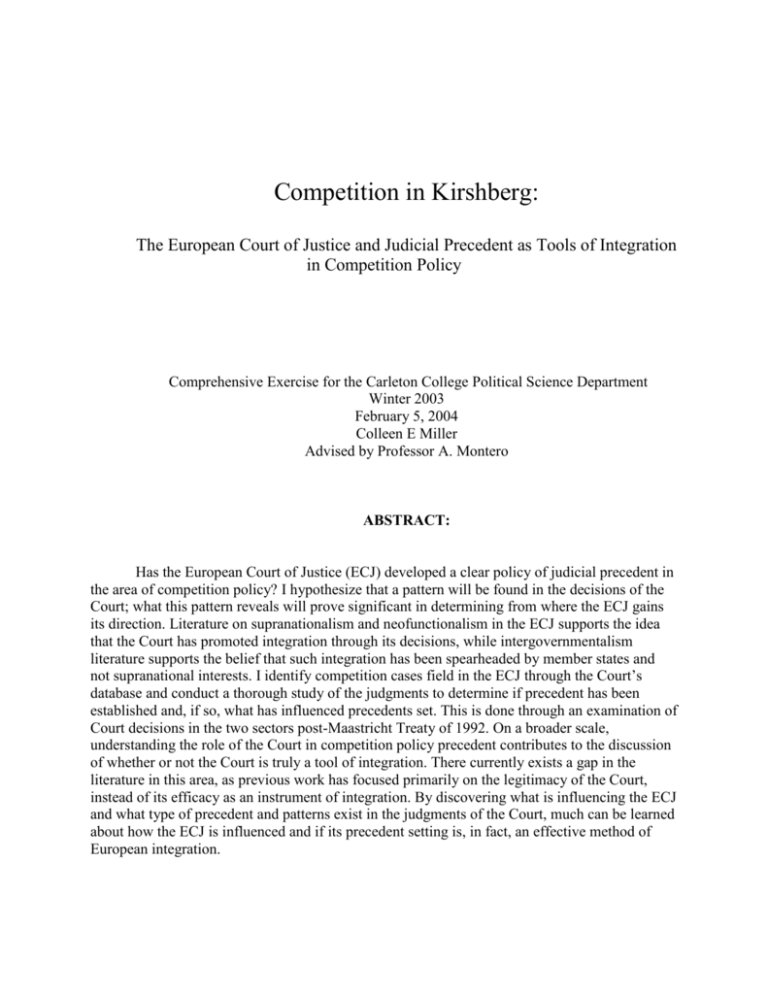
Competition in Kirshberg: The European Court of Justice and Judicial Precedent as Tools of Integration in Competition Policy Comprehensive Exercise for the Carleton College Political Science Department Winter 2003 February 5, 2004 Colleen E Miller Advised by Professor A. Montero ABSTRACT: Has the European Court of Justice (ECJ) developed a clear policy of judicial precedent in the area of competition policy? I hypothesize that a pattern will be found in the decisions of the Court; what this pattern reveals will prove significant in determining from where the ECJ gains its direction. Literature on supranationalism and neofunctionalism in the ECJ supports the idea that the Court has promoted integration through its decisions, while intergovernmentalism literature supports the belief that such integration has been spearheaded by member states and not supranational interests. I identify competition cases field in the ECJ through the Court’s database and conduct a thorough study of the judgments to determine if precedent has been established and, if so, what has influenced precedents set. This is done through an examination of Court decisions in the two sectors post-Maastricht Treaty of 1992. On a broader scale, understanding the role of the Court in competition policy precedent contributes to the discussion of whether or not the Court is truly a tool of integration. There currently exists a gap in the literature in this area, as previous work has focused primarily on the legitimacy of the Court, instead of its efficacy as an instrument of integration. By discovering what is influencing the ECJ and what type of precedent and patterns exist in the judgments of the Court, much can be learned about how the ECJ is influenced and if its precedent setting is, in fact, an effective method of European integration. Introduction The European Court of Justice, a part of the European Union since its inception, is a unique and important institution. Each of the fifteen member state of the European Union has, through EU membership, ceded judicial authority to the body. Thus, the judgments of the Court supercede those of any national court. Clearly, the Court holds enormous power over the government in Brussels, and the member states themselves. Yet, the nature of this power has not always been as transparent. Political scientists and legal scholars have long debated the importance and the impact of the European Court of Justice. Within the European community, the Court itself is the product of supranational integration. That is to say, the European Court of Justice exists as its own body, not as a consensus of state actors. However, I argue that the decisions of the Court themselves cannot be assumed to be a direct continuation of this supranationalism. While the very makeup of the Court and the powers it possess leave little ground for dispute of its supranational nature, the role of the Court itself in the project of European integration has not been examined as closely. The larger question I address is that of whether or not the ECJ behaves as a supranational institution in the spirit of true integration. However, this is not a question with a clear answer, or even a clear approach to finding an answer. Therefore, I argue that this question can be explored best through the decisions of the Court itself. If the Court is using its power to create a solid body of European law through precedent, it is creating a supranationalistic influence in the Union through the creation of European legal standards and ideals. Precedent, or the concept of judicial decisions being used as a standard in subsequent similar cases, indicates that the Court is a mindful body conscious of its place in European law; that it is in fact creating European law through its decisions. If precedent is not a lynchpin of the decisions of the European Court of Justice, the Court becomes less an institution forwarding a supranationalistic Europe and more a body of temperamental decisions driven by varying and unstable motivations. Precedent setting indicates a Court with a European mindset and an eye toward a singular body of European law. Why is this distinction so important? The European Union does not have a constitution, per se, but instead uses treaties as its legal guidelines. The interpretation of these treaties falls to the Court in all instances of dispute, much like the American Supreme Court interprets the constitutionality of laws passed by the American Congress. When the European Court of Justice relies upon precedent setting in its decision-making, it is essentially creating new laws for the European Union. Although the European Parliament can pass laws and the European Commission can enact policy, it is the Court that holds the privilege of interpretation. When the Court builds upon the foundation of its own decision, it lends credibility not only to the institution itself but also the judgments of the Court. Barristers and solicitors in the European Union can gain an expectation of what will be considered legal in the European community when a reliable precedent is perceived. Thus, all member states will come to have congruent policies and attitudes toward competition, human rights and other areas of law the European Union’s acquis communautaire applies to.1 One of the pillars of the European Union, the European Court of Justice plays an important role in the economic and social integration of the Union.2 Determining if the Court is, in fact, setting serious precedent in its areas of control approaches the question of whether the Court has serious influence in European integration. Furthermore, examining the characteristics 1 Acquis communautaire refers to the entire body of European laws and treaties, as well as those documents resulting from Intergovernmental Conferences. 2 See Renaud Dehousse’s The European Court of Justice: The Politics of Judicial Integration for more on the European Court of Justice as a European Union institution. of the precedents established by the court may determine whether the Court is as supranational as it was intended to be at its creation, or, conversely, whether it has been pulled forward by individual state actors. After examining the literature on the topic, I argue that precedent-setting itself is a sign of supranationalist behavior. I offer two competing hypotheses: 1) that of precedent in the Court’s decisions is driven by either a supranational or neofunctional positions of the Court or, 2) it is the result of the influence of a few key actor states (such as France or Germany). Ultimately, the process of integration will be reflected in the ability and tendency of the Court to create precedent in areas of policy it has jurisdiction over. I conclude that the Court’s influence has been somewhat ignored and underestimated by the literature, and perhaps, Europeans themselves. Three competing approaches have vied for the attention of European Union scholars since the inception of the EU. These approaches are: intergovernmentalism, supranationalism, and neofunctionalism. While these three approaches differ greatly, many have argued that no single approach can address the phenomenon of European Union integration. Therefore, a clear understanding of all three is essential for determining how integration occurs within the European Union. In answering the question of the role of the European Court of Justice in Europe’s competition policy, it is essential to evaluate these schools of thought on integration if we are to answer the question of whether the European Court of Justice is, in fact, a successful supranational organization with the intent of furthering a deepening of European integration, or if we are to gain an understanding of how that organization fosters pan-European integration. Literature Review Intergovernmentalism Intergovernmentalism is the most state-centric model of the integration approaches (Hooge and Marks, 2001). This state-centric, or intergovernmental, approach embraces the member states of the European Union as the primary and most influential actors within that body. In the state-centric model, member states are not seen has having surrendered sovereignty to the European Union as a separate entity; instead, decisions are made and compromises reached by the fifteen member states, who often bargain down to the lowest common denominator of the various member states’ national governments (Hooge and Marks, 2001). Intergovernmentalism has been defined as an “arrangements whereby nation states, in situations and conditions they can control, cooperate with one and other on matters of common interest… existence of control, which allows all participating states to decide the extent and nature of his cooperation, means that a national sovereignty is not directly undermined” (Nugent, p. 502, 1999). Under a purely intergovernmental approach to integration, no nation would find themselves forced to a deeper level of integration than desired. Yet, applying this approach to the ECJ reveals serious flaws. Because each member state cannot decide, occasion by occasion, if they want to cede sovereignty to the Court, the extent to which they cede judicial primacy is determined in the individual treaties of the European Union, already part of the acquis communautaire each member state must adopt when seeking membership. Intergovernmentalism, as a theory born out of mainstream international relations theory, holds that states will be wary of ceding sovereignty in high politic areas such as foreign policy and defense, where they are more likely to have a deep-rooted national policy within their governments (Liefried, Pierson, and Hoffmann, 1996). Therefore, intergovernmentalism cannot answer the problem of the fact that, once ceded, this type of sovereignty is not easily returned to the national courts. Furthermore, it is impossible to claim that the European member states are able to ‘control’ their environment when it comes to the European Court of Justice, as nonmember state parties can bring an action to the Court. However, it must be acknowledged that intergovernmentalism does have a role in European Union politics at the level of the aptly named ‘intergovernmental conferences,’ from which all major European Union treaties have emerged. Ultimately, the ECJ is not as easily explained by intergovernmentalists, as it does not have as much to do with the areas of high politics such as security and monetary policy, but instead concerns itself with low and medium levels of policy. Neofunctionalism Neofunctionalism is also a much-popularized approach to integration. The neofunctionalist approach has often been used by political scientists to explain the dynamics of regional integration through functional linkages between policy areas (Corbey, 1995). Neofunctionalism focuses on organizations such as the Commission of the European Union and various interest groups to explain the integration process. Hence, in neofunctionalist theory, member states are not required to hold a continual pro-integration stance, as other vehicles are in play during times of national integration stagnation. This lack of state-centricism is a strength of neofunctionalist theory because it is clearly not the case that all member states are always in favor of further, or even continued, integration. Neofunctionalism helps to explain the continued existence and slow progress of the Union, even during times of deep Euroskepticism. Although member states were often unwilling to move forward in integration during the 1970s and 1980s, the momentum of institutions and interest groups kept the European Union alive. Neofunctionalism approaches imply that times of Euroskeptism would not prevent integration from moving forward in certain chambers of the European Union. However, I argue that one weakness of the neofunctionalist approach lies in the fact that, for true deepening to occur, there must be movement by member states. Stagnation of integration has occurred when member states are not in a pro-integration period, as areas of policy influence cannot grow without the consent of all member states (Mazey in Richardson, pp. 24-27). However, in support of neofunctionalismt orientation, it must be acknowledged that the European Court of Justice is somewhat exempt from several of the many pitfalls of a nonintegration minded Europe faces. This is because there is no requirement of a qualified majority within the body for the ECJ to take action. However, as noted, intergovernmentalism also plays a role and neofunctionalism on its own does not provide a satisfactory answer to the question of how the ECJ works as a tool of integration. Neofunctionalim, as it currently stands, does not take into proper consideration the role and influence of the states and ignores the fact that fifteen member states must work together in some way, shape or form for integration to make substantial progress. No matter how much a European institution may desire further integration, it is not possible to ignore the member state level of the problem. Supranationalism Supranationalism speaks to many of the shortcomings of both intergovernmentalism and neofunctionalism when addressing whether the European Court of Justice is promoting integration within the European Union. Supranationalism is commonly defined as a process involving “states working together with one and other in a manner that does not allow them to retain complete control over developments… states may be obliged to do things against their preferences and their will” (Nugent, pp. 502-503). This is the principle that motivated Jean Monnet, whom many have termed the father of the European Union (Monnet, 1976). (The supranationalism movement is also occasionally compared to American federalism.) Monnet held a strong desire to “provide a framework through which the ‘brightest and best’ could be enabled to pioneer new ideas” for the Community (Wallace, H. in Wallace and Wallace, 1996, p. 502). Some argue that the supranationalist approach best addresses the idea of integration because it is the theory which the founders of the Union themselves had in mind (Nugent, pp. 502-506). Thus, it can be argued that supranationalism played a large role in the initial design of the modern European Union, including the founding of the European Court of Justice (Heisenberg and Richmond, 2002). From Monnet’s role as the founder of the European Community, supranationalism has always been one of the most appealing explanations available for the ability of the Union to expand its areas of influence. The Treaties of Rome, considered by the ECJ to be the first pieces of the European Union’s ‘constitution,’ ushered in a policy of supranationalism by awarding the Court the right to declare mergers in either coal or steel unlawful; this provided the ECSC with immense political and economic power leverage in the six founding member states (Allen in Wallace and Wallace, p. 169). The European Union’s Common Agriculture Policy is another example of supranationalism within the European Union and one of the best anecdotal supports than can be given. States have willingly surrendered state sovereignty to the European Union, which has become responsible for much of the farming policy and subsidy systems for European farmers. This supranationalism created a tight link between the farmers and the European Union government in Brussels, cutting out the ‘middle man’ of nation states in many cases (Wallace and Wallace, p. 99). Integration Theory and the European Court of Justice To expose a weakness of supranationalism, many of the integration developments that the approach describes so well tend not to fall under the category of ‘high politics.’ Intergovernmentalism can easily argue that supranationalism only impacts ‘low politics;’ the CAP is an example of supranationalism impacting only low- and mid- level politics, but not high politics. Ironically, although the Maastricht Treaty did make serious strides in this area, it is in areas of high politics, such as defense and foreign policy where the European Union has come under criticism for a lack of serious integration. However, ultimately, economic integration is not easily defined as an area of just ‘low politics’ or ‘high politics’. To understand the integration process we must examine all three literatures with respect to the European Court of Justice. The European Court of Justice was created with the original purpose of establishing a free trade area and removing distortions of free trade (Allen in Wallace and Wallace, p. 160). It is because of this beginning that the ECJ has found itself in possession of a strong supranationalism power. Although some scholars have negated this by saying the Court is only a glorified pawn of the stronger member states, it is difficult to find solid support for this theory in the literature, particularly given that each member state, de facto, selects a judge of their own choosing (Richardson, 1996. p. 170). This practice makes ‘stacking’ the Court in favor of a particular member state easier said than done. Even small member states hold the same potential influence with the Justices when examining the makeup of the bench. Some observers have made the argument that the Court falls into the categories of neofunctionalism and supranationalism because of the fact that the EU treaties make up the ‘constitution’ of the European Court of Justice and it has been combined with the spilling over (a trademark sign of neofunctionalism) of Court policy into those of health and social welfare (Nugent, pp. 507-508). The role of non-state actors in neofunctionalism theory is also present in the Court’s integration advances, as attorneys are given “a more or less free hand to speak to the Commission, Council, and national governments” (Burley and Mattli in Nelson and Stubbs, 1998, p. 244). This type of integration appears a hybrid of the two theories of integration theory, strengthening the conviction of many European Union scholars that any single theory will fail to sufficiently explain a beast as complicated as a half-century of integration of unprecedented depth. Weighing Integration Approaches Reviewing the three most prevalent approaches to European Union integration, it suggests that a combination of supranationalism and neofunctionalism best explain the phenomenon. This goes directly toward addressing the idea of judicial precedence in competition policy, which in turn addresses the idea of the European Court of Justice as a powerful tool of European integration. The European Union, and the European Court of Justice, have grown into independent political entities beyond the control of any single member state. As the Union becomes more complex and grows in size, an expansion of the jurisdiction of the Court grows, spilling into new policy areas. In contrast, the intergovernmental theory becomes more and more difficult to both apply and operate under. Having identified the characteristics of the three main approaches of European integration, I offer two key hypotheses: 1) the European Court of Justice will be found to reach its judgments through consideration of precedent and European Union treaties and 2) that the precedent in the Court’s decisions is driven by either a supranational or neofunctional positions of the Court (or a combination therein).3 At this point, I argue that little intergovernmentalism will be found within the Court, but instead there is a preponderance of supranationalitic or neofunctionalist behaviors in the Court’s decisions. 3 While this may appear to be two competing hypotheses, as evidenced above, the literature is quite supportive of the European Court of Justice being characterized by more than a single theory of integration. The theories of neofunctionalism and supranationalism are complementary in this instance. Research Design, Etc. Using the process-tracing method, I will be evaluating the affects and implications of policy of the European Court of Justice as a tool of integration within the European Union. While the larger question within the study of the European Court of Justice has typically been that of the ability of the Court to foster a deepening of integration, I will be approaching the more specific question of whether a clear policy of judicial precedence in the area of competition policy has developed, and if so, what its’ implications are. To address this question, I have investigated the three different approaches to integration theory: intergovernmentalism, neofunctionalism, and supranationalism. I am attempting to explain precedent setting outputs as a function of either intergovernmental, supranational, or neofunctional processes. The diagram below provides a visual perception of my research question and model. [FIGURE 1.1 HERE] The European Court of Justice makes available its judgments and opinions on its official website. Judgments and opinions from 1968 through 1996 are available in a case-number format; there is no division of types of cases. From 1997 through the present, the Court has developed a searchable database. As stated in the abstract, I intend to examine the decisions of the Court postMaastricht. This has proven more difficult that anticipated due to the nature of the database. Over the coming weeks, I will add judgments from the period of 1992 through 1996 to my dataset. The latter (chronologically speaking) half of the dataset encompasses 1997 through the end of 2003. Only judgments were used, as opinions and other judicial documents would not be creating a law or policy. Due to the fact that I am trying to establish a pattern of precedent setting, the opinions of the Court do not hold as much sway when attempting to prove or disprove my hypotheses. The ECJ database allows one to select only judgments of the Court and this was my first narrowing of the dataset. From there, the ECJ database divides the judgments into several categories by area of law, such as ‘appeal,’ ‘public undertakings,’ ‘environment,’ and ‘European citizenship.’ I selected ‘competition’ as my criteria and did not further narrow my search. The rationale for this becomes somewhat complicated. After extensive investigation, it was determined that there simply were not enough cases filed under the ‘competition’ criteria in the database to be able to establish a solid case study of two sectors. The low number of cases made it impossible to determine precedent or significant patterns in the data, as the impact a single case had on the dataset was too great. It is for that reason that I moved away from the case study by sector method and instead examined the breakdown of cases filed as competition cases with respect to actors, as will be explained shortly. The results, with the search criteria outlined above, returned 308 cases. However, the search engine did not separate decisions from the Court of First Instance from the Court of Justice. Cases from the Court of First Instance were thrown out, as they are not handled in the same manner of those that reach the Court of European Justice and would have made fair comparison impossible. The case-numbering system of the European courts simplified this process, as all European Court of Justice cases begin with the letter ‘C’ followed by a case number; those from the Court of First Instance begin with a ‘T.’ Each case beginning with a ‘C’ was then word searched to double-check the results of the search engine. Several cases were omitted due to the fact that the word ‘competition’ seemed to relate only peripherally to the case, i.e. the Court referred to a treaty that dealt with multiple topics including competition. At the conclusion of the word search portion of the data collecting, 55 cases were selected for the time period 1997 through 2003. The judgments vary in length from six pages to nearly 100. The next step in creating the data was selecting several categories to evaluate what types of cases are coming before the ECJ and who is bringing these cases to the Court. The main categories begun with are: judgments listing member states as parties, judgments listing the European Commission as a party, those judgments referring to national court judgments, and judgments wherein corporations or firms took legal action against each other (i.e. Milka sues Lindt over access to CAP-subsidized milk). Clearly, some cases will fall under more than one and it is possible that a case will fall under none. The rationale behind using these categories varies by category, but by examining each of these four areas, much more can be examined. When looking at cases that refer to national courts, the relationship between the European Court of Justice and member state courts is investigated and can prove much about how the ECJ is both impacting national courts and whether it is holding up decisions of these lower courts. Are some member states appearing in the Court more often than others? The Italians, in particular, seem to have national cases arrive before the ECJ on a fairly regular basis. Judgments in which a firm or firms have taken action against another firm or firms are a good comparison to those cases which involve a member state. Cases in which the European Commission is involved provide excellent framework for establishing the idea of precedent, the driving question of this paper. The European Commission is where most competition policy is supposed to be overseen, and a case against the Commission is usually accusing the Commission of failing to follow the directives of European treaties, i.e. European law. In the Council Regulation (ECC) No 4064/89, Article 21(1) stated that “subject to review by the Court of Justice, the Commission shall have sole jurisdiction to take the decisions” in cases of ‘concentration,’ i.e. mergers, monopoly or lack of competition. Cases in which member states are listed as parties are important to determine whether or not the ECJ is ‘siding’ with member states on a regular basis, and if so, which member states are basking in the favor of the Court. In each of the decisions of the Court, the judgment is presented, with the rationale as to how it was arrived at. This sort of format is somewhat similar to the American system of stating ‘findings of fact’ at the end of a trial. The ‘rationale’ should, and in the vast majority of case—if not all—does, refer to either European Union ‘law,’ i.e. treaties and earlier cases or national law. Through a careful reading of the ‘judgment’ section of each of the cases, it can be determined how many different pieces of European law4 are referred to, as well as how many other cases are referred to when reaching a judgment. (One difficulty here is that the Court has, on occasion, cited case law just that simply: by referring to “case law.”) This information is presented in an Excel™ spreadsheet, as well as graphed for averages. In its next draft, this paper shall include a list of all cases by case number and parties that are in the dataset. The cases themselves will be available in word documents on a Cd rom to facilitate easy word searches. Within the 55 cases taken from 1997 through 2003, eleven mention member states as parties. This does not include or refer to those cases brought ‘up’ from national courts. Fully thirty-three, or more than two-thirds of cases, name the European Commission as a party. Nineteen cases refer back to a national court, usually asking for a preliminary ruling on a matter, pursuant to an article of a European Union treaty. Italy and the French Republic had the most number of cases brought forth from the national courts. The case C-137/00 is an excellent example of the use of case law and precedents in the European Union. Relating to the Common Agriculture Policy and milk monopolies, the member 4 European law shall be considered the European Union treaties and other pieces of acquis communitaire. state of the United Kingdom has asked the Court of European Justice for a preliminary ruling in the proceedings. The very action of the parties asking for the input of the Court lends the Court legitimacy to the Court in the national courts of the United Kingdom. In a judgment more than 129 paragraphs long, the Court cited several portions of the European Economic Community treaty, the European Commission’s Common Agriculture Policy, the Fair Trade and Competition acts, and more than twenty previously heard cases by the European Court of Justice. Each of the 55 cases will be presented in a spreadsheet with respect to this material, in order to best compare how often case law is being cited, with respect to number of cases and number of times within cases. This strong presence of case law and European Union treaties (i.e. European law) upholds my argument that the European Court of Justice is indeed a body setting precedent and establishing its own body of law by building from a growing foundation of earlier treaties and judgments. Lacking strong indication that the ECJ is continually siding with a specific member state, the argument of the ECJ as an intergovernmental body is clearly flawed. The more interesting question for future research then becomes whether or not the ECJ is siding continually with its own ‘national’ government: that of the European Commission. This is a complicated issue because the Commission has an obligation to interpret competition policy but is also a fellow European institution. Thus, correlation in such cases cannot assume causation. To address the broader question of whether or not the European Court of Justice is indeed a tool of integration, beyond its supranational or neo-functional behaviors, one only has to look again at the citation of case law. Each firm, each sector, each member state is being held to an established and transparent standard that is pan-European. Each is being forced, under the law and under penalty of fines, to move toward the European vision of competition policy. Like the United States in its founding, member states retain all rights and areas of policy not specifically given to the Union. However, those rights and areas of policy are growing smaller. Even those that remain are becoming more and more similar through interaction with the integration-minded institutional organs of the European Union. Research Question and Model Figure 1.1 What has influenced the possible development of a clear policy of judicial precedence in the European Court of Justice’s competition policy? Independent Variable Pressure from large or influential member states Intellectual leaders leave state with only limited input—Monnet’s ‘best and brightest’ of bureaucrats and institutional interests Sub-state actors, interest groups seeking coordinated solutions beyond any one state actor Theory Dependent Variable Intergovernmentalism Theory (high politics victory) Supranationalism Theory (bureaucratic politics victory) Neofunctionalism Theory (low politics victory) Three hypothetical inputs driving ECJ precedent setting European Court of Justice Precedent Setting Selected/Incomplete Annotated Bibliography Methodological Resources: Johnson, Janet Buttolph, Joslyn, Richard, and Reynolds, H.T. Political Science Research Methods: Fourth Edition. CQ Press: Washington, DC. 2001. Introductory level introduction to political science methodology; jurisprudence research. King, Gary, Keohane, Robert O., and Verba, Sidney. Designing Social Inquiry: Scientific Inference in Qualitative Research. Princeton University Press: Princeton. 1994. Upper-level commentary on political science methodology; methodological validity addressed. Little, Daniel. Varieties of Social Explanation: An Introduction to the Philosophy of Social Science. Westview Press: Boulder. 1991. Provided background reading and instruction on research methodology. Theodoulou, Stella and O’Brien, Rory. Methods for Political Inquiry: the Discipline, Philosophy and Analysis of Politics. Prentice Hall: Upper Saddle River. 1999. Provided instruction in the research process and methodology. Turabian, Kate L. A Manual for Writers of Term Papers, Theses, and Dissertations 6th Edition. Uinversity of Chicago Press: Chicago. 1996. Used to answer stylistic questions. Van Evera, Stephen. Guide to Methods for Students of Political Science. Cornell University Press: Ithaca. 1997. Mid-level commentary on political science methodology; typology and validity addressed. Books: Greenwood, Justin. Interest Representation in the European Union. Palgrave MacMillan: Hampshire. 2003. Background information on interest groups within the European Union and the politics of the European Union in Brussels. Hooge, Liesbet and Marks, Gary. Multi-Level Governance and European Integration. Rowman and Littlefield: Lanham. 2001. Provided background on theories/approaches of European Union integration. Kitschelt, Herbert; Lang, Peter; Marks, Gary; and Stephens, John D. Continuity and Change in Contemporary Capitalism. Cambridge University Press: Cambridge. 1999. Provided discussion of the European Court of Justice as a supranational actor in global capitalism. McCormick, John. Understanding the European Union. Palgrave MacMillan: Hampshire. 2002. Introductory text to European Union policy background necessary for understanding theories and approaches to integration. Meny, Yves; Muller, Pierre; and Quermonne, Jean-Louis, Eds. Adjusting to Europe: the Impact of the European Union on National Institutions and Policies. Routledge: London. 1996. Discussion of the impact of the European Court of Justice on national courts provided; i.e. the far-reaching impact of supranationalism in the European Union. Monnet, Jean. Mémoires. Librairie Arthéme Fayard, 1976. (in French) Biography of the ‘father’ of the European Union, addresses supranational intent in creation of the European Union and European Court of Justice. Nelson, Brent and Stubb, Alexander, eds. The European Union: Readings on the Theory and Practice of European Integration. Palgrove: Hampshire. 1994. Self-explanatory; addressed theories and approaches to European integration and their effects on the Court. Nugent, Neill, ed. The Government and Politics of the European Union. Fourth Edition. Palgrove: New York. 1999. Mid-level text on European Union institutions and policies, including popular and prevalent theories and approaches to integration and interest politics. Richardson, Jeremy, ed. European Union: Power and Policy Making. Toutledge: London. 1996. Provided discussion on various issues of European Union integration and stagnation through various authors. Rosamond, Ben. Theories of European Integration. Palgrove: Hampshire. 2000. Self-explanatory evaluation of theories and approaches to European integration. Wallace, Helen and Wallace, William, eds. Policy Making in the European Union. Oxford Press: Oxford. 1996. Discussion of foundational principles of the European Union and how they have evolved over the last half century. Zeff, Eleanor E. and Pirro, Ellen B., Eds. The European Union and the Member States: Cooperation, Coordination, and Compromise. Rienner: Boulder. 2001. Systematic approach to the position of each of the fifteen member states of the European Union to the processes of integration and pan-European bargaining. Articles: Burley, Anne-Marie and Mattli, Walter. Europe Before the Courts: A Political Theory of Integration. International Organizations. Vol. 47, No. 1. Winter 1993. pp. 41-76. Discussion of integration theory. Corbey, Dorette. Dialectical Functionalism: Stagnation as a Booster of European Integration. International Organizations. Vol. 49, No. 2. Spring 1995. pp. 253-284. Foundational article addressing many of the different ‘schools’ of European integration and their applicability, as well as their weaknesses. Garrett, Geoffrey. The Politics of Integration in the European Union. International Organizations. Vol. 49, No. 1 (Winter 1995), pp. 171-181. Discussion of supremacy of the European Court of Justice within the Union (i.e. over national courts) and the constitutional nature of the Treaties of the European Union in the decision making of the European Court of Justice. Heisenberg D, Richmond A. Supranationalism institution-building in the European Union: a comparison of the European Court of Justice and the European Central Bank. Journal of European Public Policy. 9 (2): 201-218 April 2002. Discussion of supranationalism theory as applied to the European Court of Justice. Liefried, S; Pierson P.; and Hoffmann, S. European Social Policy: Between Fragmentation and Integration. Foreign Affairs. 75 (2) 155-155 Mar-Apr. 1996. Addresses the weaknesses and strengths of intergovernmentalism as a high politics area. Internet Database: The decisions of the European Court of Justice can be found online at the European Union’s Official Website.
